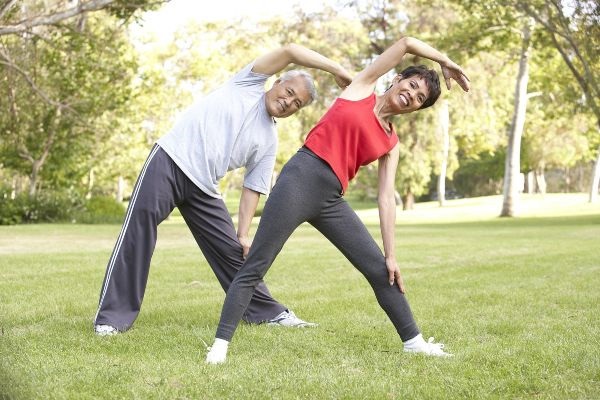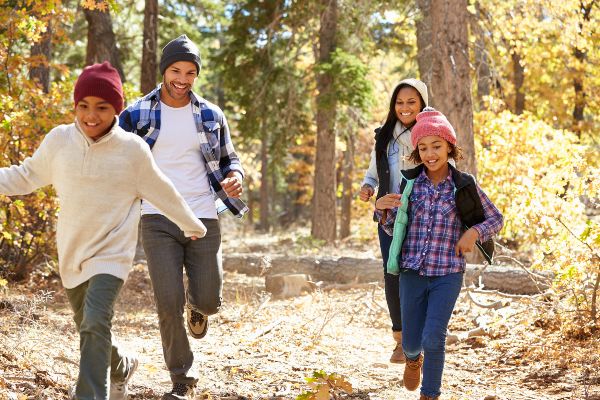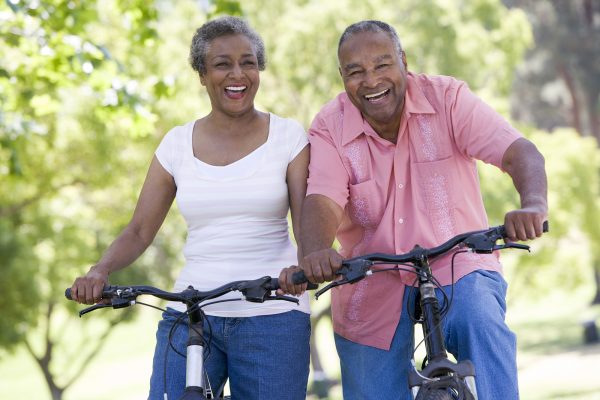Physical activity isn’t just exercise – it is any way you move your body using energy. Dancing, walking, and gardening are all fun examples of physical activity.
Types of Physical Activity
The most important intensities of physical activity for health are moderate and vigorous – both of these make your heart and breathing faster.
Moderate physical activity includes activities like:
- brisk walking
- gardening
- dancing
- casual biking
- golfing
- casual swimming
Vigorous activity includes activities like:
- very fast walking
- jogging
- biking quickly
- intense yard work
- swimming laps
- competitive sports
Vigorous activity can be done in less time that moderate physical activity with similar health benefits.
Another important thing to consider is the type of exercise you are doing. Aerobic, muscle-strengthening, bone strengthening, balance, and stretching activities all benefit your health in different ways.
- Aerobic activities like jumping rope and swimming make your heart and breathing faster – so they are great for your heart and lungs.
- Muscle strengthening activities like doing push-ups or lifting heavy objects make your muscles work and grow.
- Bone-strengthening activities like jumping and running make your bones stronger.
- Balance and stretching activities like yoga and dancing keep you stable and keep you limber.

As you can see, there are a lot of types of physical activity – but many activities fall into more than one of these categories.
Check with your doctor.
Check with your doctor before changing your current physical activity routine! It is important to make sure any changes are safe and will benefit your health.

Guidelines for Physical Activity for Americans: [1]
- Children (3-5)
- Be physically active throughout the day to help with growth and development.
- A reasonable target is 3 hours or more of active play (light, moderate or vigorous intensity) per day
- Children-adolescents (6-17)
- 1 hour or more of moderate-intense aerobic activity every day
- Some activities should include muscle-strengthening and bone-strengthening activities like jumping rope or playing basketball at least 3 days per week.
- Adults 18-64
- Get 150 to 300 minutes of moderate-intensity physical activity or 75-150 minutes of vigorous-intensity physical activity every week.
- Even a few minutes of moderate-to-vigorous physical activity throughout the day to meet the required minutes per week is beneficial.
- Do muscle-strengthening activities at least 2 times a week
- Older Adults
- Should follow the guidelines for adults, and should include balance training as well as aerobic and muscle-strengthening activities.
- Older adults should be as physically active as their chronic conditions and physical abilities allow.
- Older adults should consider how chronic conditions they have may affect their ability to safely perform physical activity.
- Older adults should do physical activity at a level that is appropriate to their level of fitness
Typical Barriers to Physical Activity
Finding Time
Sometimes it can feel like there is no time in the day to fit in physical activity, but there are plenty of ways to incorporate physical activity into your busy schedule.
- Play with your kids when they are out of school – tag, jumping rope, and other outdoor activities can be fun for the whole family
- If you work sitting down, get up every hour and briskly walk for a minute or two.
- Take a short, brisk walk during your lunch break after eating.
- Stretch lightly at the beginning of the day to wake up your muscles
- Choose family activities that involve activity – like swimming, walking the dog (if you have one) and biking.
- Wake up 15 or 30 minutes earlier and use that time to start your day with a walk. You can make up the lost sleep by going to bed a little earlier as well.
- If you can walk, walk – if there is a short distance you need to go, try walking instead of driving
- Take the stairs instead of the elevator or escalator
Too tired to do physical activity?
Often, we either don’t get enough sleep, or are busy, and we feel that we are too tired to do physical activity. However, physical activity increases energy during the day and increases sleep quality at night, so getting more physical activity will make you less tired. Here are some tips if you still feel too tired to get moving:
- Think about your day – if you feel most energized after your morning coffee, then get your physical activity then. If you feel good in the middle of the day, use part of your lunch break for a walk. It is all about what works for you
Physical activity isn’t always fun.

Certain types of physical activity aren’t right for everyone. For example, you might enjoy walking briskly, but not jogging. Or you might enjoy riding your bike, but not swimming. It is important to find a type of physical activity you enjoy, so you will be more likely to actually do it! You might also find that as your body gets in better shape, you start to enjoy types of physical activity that you found uncomfortable before. Here are some fun ideas:
- Try a free online workout video – YouTube and other video hosting sites are full of all kinds
- Find a nice park or nature trail – getting some fresh air and appreciating nature makes walking or jogging more enjoyable
- Think out of box – hoola-hooping, water aerobics, and other creative activities can be more fun than traditional physical activities
Don’t have any equipment? No problem.
Often, we think of gyms, equipment, and workout gear when we think of physical activity. But none of these things are really needed. Activities like push-ups, yoga, and dancing don’t require any equipment or gear! We are lucky in Georgia to have great weather (most of the time), and the outdoors is often more comfortable than a gym. Many parks have workout equipment built in… (Not sure if there is a resource to find it in your area).
Want to learn to do new types of physical activities – but don’t where to start?
The internet has a lot of free guides and videos to teach you how to get into new activities. There are also free apps like couch to 5K that guide your physical activity so that you can get into better shape slowly and comfortably. Trying new types of physical activity, like yoga, can be a fun family activity.
If you don’t think you are “athletic.”
Don’t worry about setting intense goals or competing with anyone. Physical activity is about keeping your own body healthy. Non-competitive activities like dancing, walking, and gardening are all good forms of physical activity.
Worried you will become injured?
Talk to your doctor about what kinds of physical activity are appropriate for your condition. You might be able to do more than you think.
Benefits of Physical Activity
Weight Management
One great benefit of physical activity is that it helps with weight management. Regular physical activity helps you maintain rather than gain weight, and can aid in weight loss by burning calories.
Decreased Stress
Physical activity is a great stress reliever, so it is healthy for your body and mind.
Social/Family Life
Physical activity is a great way to socialize. By participating in a physical activity group, you can grow closer with your friends and meet new people (even if the activity group is done in a virtual setting during the pandemic). It is also a great way to bond with your family. Going for walks, playing games, or doing other activities together can be a fun way to spend time together.
Wellness and Longevity
Physical activity keeps you well by decreasing the risk for many diseases like heart disease, type 2 diabetes, and obesity. Physical activity also keeps your muscles and bones strong, which is important as you get older.
Improved Mood and Energy
Participating in physical activity causes a release of “feel-good” chemicals called endorphins in the body. These can make you feel happier and more relaxed. And by getting your body into better shape, you will feel more energized throughout the day. Tasks that before were winding (like walking quickly) can become much easier. Another way exercise gives you more energy is by helping you sleep better at night. The same amount of sleep can be much more satisfying after a day with plenty of physical activity.

Ideas for Kids
- Find a jungle gym – most parks have jungle-gyms where kids can climb, swing, slide, and run.
- Create a treasure hunt
- Start a garden – flower seeds are inexpensive and many are easy to grow (zinnia, marigold, sunflower) and many herbs (basil) and veggies (cucumbers, green onion, green beans) are easy as well. Growing a veggie garden gives you the added benefits of saving money and increasing vegetable intake.
- Run through sprinklers or a have a water balloon fight to keep cool in the summer
- Let your kids use their imaginations
- Limit screen time – keep TV, video games, phone, and other screen time to 2 hours or less a day
- Encourage involvement in organized sports
- Encourage involvement in other forms of exercise – not all children enjoy organized sports. Many children will enjoy other activities like dancing, skateboarding, or martial arts.
- Acknowledge and praise your child for participating in physical activity
- Allow and encourage play dates – having a friend present can encourage your child to be more active
To learn more tips of getting active, check out “Move Your Way.”
The Move Your Way Campaign has tip sheets, an interactive activity planner and videos to make getting more active a little easier and fun. [2]
Revised by Leslie Davis, MS, RDN, LD, CDCES | edited by the Nutrition Education Team
Updated on March 5, 2021
[1] Health.gov- Physical Activity Guidelines for Americans, 2nd Edition